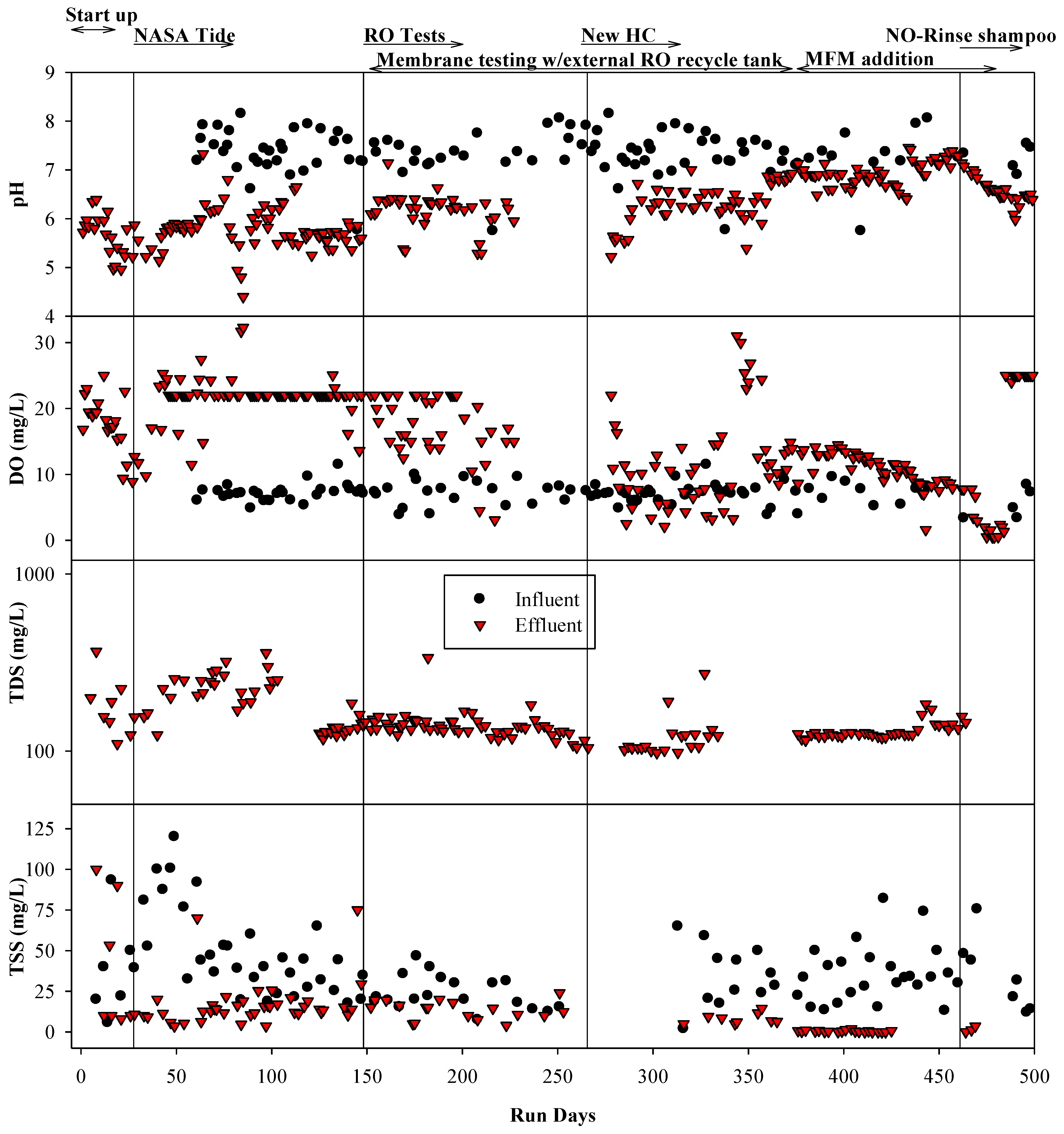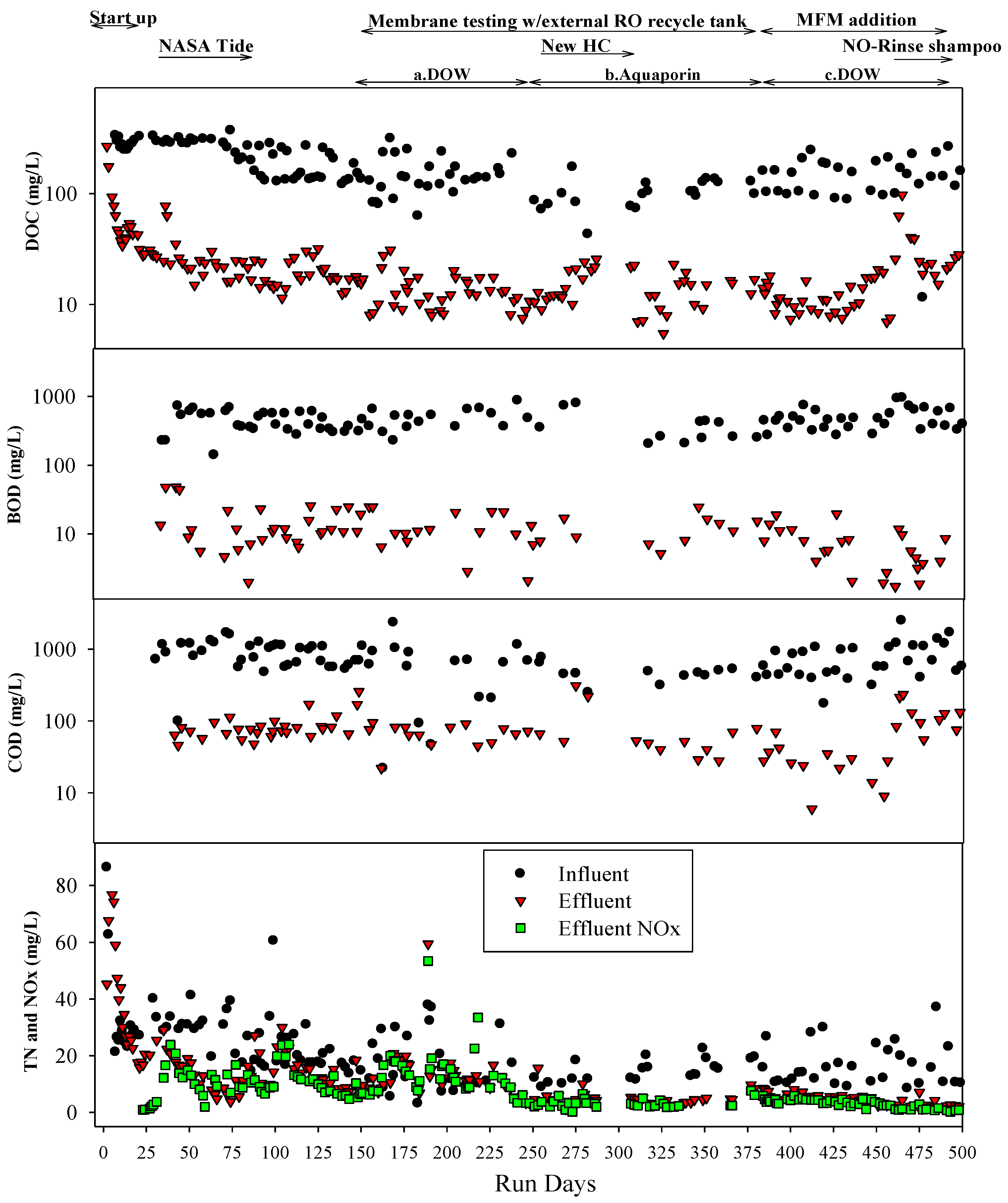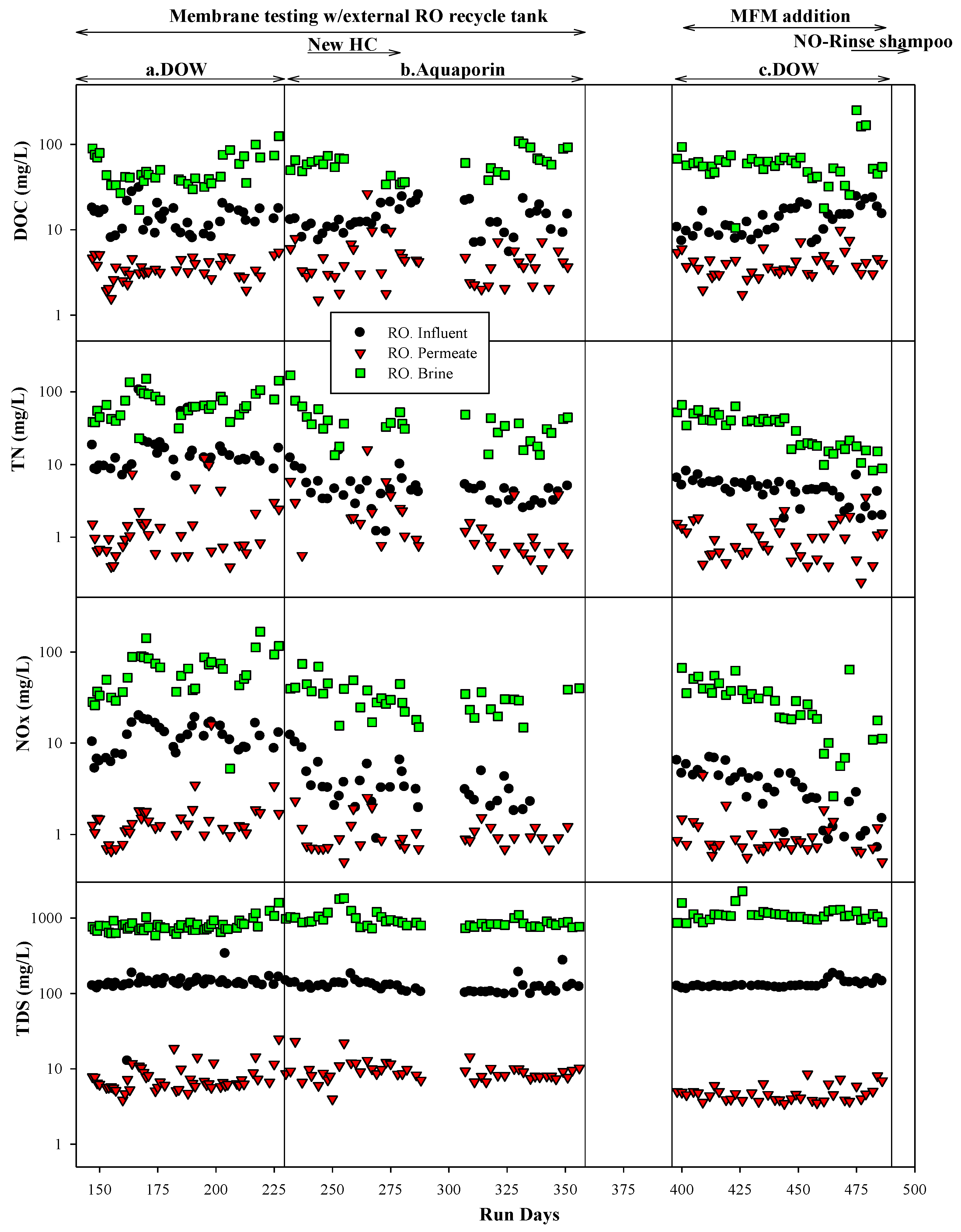Integration of Full-Size Graywater Membrane-Aerated Biological Reactor with Reverse Osmosis System for Space-Based Wastewater Treatment
Abstract
:1. Introduction
2. Materials and Methods
2.1. Graywater MABR and Reverse Osmosis (RO) System Configuration and Operation
2.1.1. The Graywater Membrane Aerated Biological Reactor Characteristics
2.1.2. Reverse Osmosis (RO) System Characteristics
2.1.3. Graywater Stream Composition and Feeding Regime
2.2. Treatment System Operation
2.2.1. Graywater MABR-RO System with Recycling Tank
2.2.2. Graywater MABR-RO system with Membrane Filtration Module (MFM)
2.3. Treatment System Testing and Analysis
3. Results
3.1. Graywater Membrane-Aerated Biological Reactor (MABR) Overall Performance
3.2. Reverse Osmosis System
3.2.1. Performance Using an External RO Recycle Tank and Impact of Commercial Membrane Type
3.2.2. The Membrane Filtration Module (MFM) Permeate as an RO Influent
4. Discussion
Supplementary Materials
Author Contributions
Funding
Institutional Review Board Statement
Data Availability Statement
Acknowledgments
Conflicts of Interest
References
- International Space Station Facts. International Space Station Facts and Figures. Available online: https://www.nasa.gov/international-space-station/space-station-facts-and-figures (accessed on 20 March 2024).
- NASA’s Space Shuttle Program Programmatic Environmental Assessment; Transition and Program Property Disposition, Section 2.1.2. Available online: https://www.google.com.hk/url?sa=t&source=web&rct=j&opi=89978449&url=https://netspublic.grc.nasa.gov/main/SSP%2520PEA_Transition_and_Program_Property_Disposition_July_2008.pdf&ved=2ahUKEwiM6NDNmbSGAxVSafUHHQRVFfoQFnoECBYQAQ&usg=AOvVaw1hsbeXiHEHYEG02-p2FWXB (accessed on 20 March 2024).
- Kayatin, M.J.; Williamson, J.P.; Nur, M.; Carter, L. Upgrades to the International Space Station Water Processor Assembly. In Proceedings of the 48th International Conference on Environmental Systems ICES-2018-163, Albuquerque, NM, USA, 8–12 July 2018. [Google Scholar]
- Anderson, M.S.; Ewert, M.K.; Keener, J.F.; Life Support Baseline Values and Assumptions, Document. NASA/TP-2015–218570/REV1, 233p. Available online: http://ston.jsc.nasa.gov/collections/TRS/ (accessed on 20 March 2024).
- Barta, D.J.; Henninger, D. Regenerative life support systems—Why do we need them? Adv. Space Res. 1994, 14, 403–410. [Google Scholar] [CrossRef] [PubMed]
- Jones, H.W. Would Current International Space Station (ISS) Recycling Life Support Systems Save Mass on a Mars Transit? In Proceedings of the 47th International Conference on Environmental Systems, Charleston, SC, USA, 17 July 2017. [Google Scholar]
- Pickett, M.T.; Roberson, L.B.; Calabria, J.L.; Bullard, T.J.; Turner, G.; Yeh, D.H. Regenerative water purification for space applications: Needs, challenges, and technologies towards ‘closing the loop’. Life Sci. Space Res. 2019, 24, 64–82. [Google Scholar] [CrossRef] [PubMed]
- Kliss, M. Understanding the NASA Ta6: Human health, life support, and habitation systems technology roadmap. In Proceedings of the 46th International Conference on Environmental Systems, Vienna, Austria, 12 July 2016. [Google Scholar]
- Williamson, J.; Wilson, J.P.; Glerich, A. Status of ISS Water Management and Recovery. In Proceedings of the 51st International Conference on Environmental Systems ICES-2022-098, St. Paul, MN, USA, 12 July 2022. [Google Scholar]
- Williamson, J.; Wilson, J.P.; Robinson, K.; Luong, H. Status of ISS Water Management and Recovery. In Proceedings of the 52nd International Conference on Environmental Systems ICES-2023-097, Calgary, AB, Canada, 14 July 2023. [Google Scholar]
- Buelke, C.A.; Alshami, J.; Casler, J.; Lewis, M.; Al-Sayaghi, M.; Hickner, A. Graphene oxide membranes for enhancing water purification in terrestrial and space-born applications: State of the art. Desalination 2018, 448, 113–132. [Google Scholar] [CrossRef]
- Shon, H.K.; Vigneswaran, S.; Kim, I.S.; Cho, J.; Ngo, H.H. Effect of pretreatment on the fouling of membranes: Application in biologically treated sewage effluent. J. Membr. Sci. 2004, 234, 111–120. [Google Scholar] [CrossRef]
- Muirhead, D. Pretreatment Solutions for Water Recovery System. U.S. Patent No. 9,878,928 B1, 23 April 2018. [Google Scholar]
- Carter, D.L. Status of the Regenerative ECLSS Water Recovery System. In Proceedings of the 39th International Conference on Environmental Systems, Savannah, GA, USA, 13 July 2009. [Google Scholar]
- Jackson, W.A.; Barta, D.J.; Anderson, M.S.; Lange, K.E.; Hanford, A.J.; Shull, S.A.; Carter, D.L. Water recovery form brines to further close the water recovery loop in human spaceflight. In Proceedings of the the 44th International Conference on Environmental Systems, Tucson, AZ, USA, 15 July 2014. [Google Scholar]
- Pruitt, J.M.; Carter, D.L.; Bagdigian, R.M.; Kayatin, M.J. Upgrades to the ISS Water Recovery System. In Proceedings of the ICES 2015133—45th International Conference on Environmental Systems, Bellevue, WA, USA, 14 July 2015. [Google Scholar]
- Jackson, W.A.; Hooshyari, G.; Gray, E.; Callahan, M.R. Hybrid Life Support System Full Scale Testing: Integrated bioreactor-desalination for an early planetary base. In Proceedings of the the International Conference on Environmental Systems, Saint Paul, MN, USA, 12 July 2022. ICES 2022-112. [Google Scholar]
- Christenson, D.; Sevanthi, R.; Baldwin, D.; Morse, A.; Jackson, W.A.; Meyer, C.; Vega, L.; Pickering, K.; Barta, D. Further investigations into the performance of membrane aerated biological reactors treating a space-based waste stream. In Proceedings of the the 45th International Conference on Environmental Systems, Bellevue, WA, USA, 14 July 2015. [Google Scholar]
- Pourbavarsad, M.; Jalili, B.; Harkins, C.; Sevanthi, R.; Jackson, W.A. Nitrogen oxidation and carbon removal from high strength nitrogen habitation wastewater with nitrification in membrane aerated biological reactors. J. Environ. Chem. Eng. 2021, 9, 106271. [Google Scholar] [CrossRef]
- Morse, A.; Khatri, S.; Jackson, A. Treatment efficiency and stoichiometry of a high strength graywater. Water Environ. Res. 2007, 79, 2557–2563. [Google Scholar] [CrossRef] [PubMed]
- Ewert, M.K.; Orndoff, E.; Sivik, M.R.; Niehaus, K.L.; Shearouse, W.C.; Zinna, J.M.; Patterson, S.G.; Muirhead, D.L.; Jackson, W.A. Clothes Cleaning Research for Space Exploration. In Proceedings of the 51st International Conference on Environmental Systems, Saint Paul, MN, USA, 12 July 2022. [Google Scholar]
- Muirhead, D.L.; Moller, S.L.; Adam, N.; Callahan, M.R. A Review of Baseline Assumptions and Ersatz Waste Streams for Partial Gravity Habitats and Orbiting Micro-gravity Habitats. In Proceedings of the ICES-2022-388—51st International Conference on Environmental Systems, St. Paul, MN, USA, 12 July 2022. [Google Scholar]
- Muirhead, D.L.; Marshall, S.; Romero, L.; Adam, N.; Callahan, M.R. Baseline Assumptions, and Ersatz Waste Streams for Partial Gravity Habitats with Mobile Female and Male Crew. In Proceedings of the 52nd International Conference on Environmental Systems was held in Calgary, Calgary, AB, Canada, 16 July 2023; Available online: https://hdl.handle.net/2346/94762 (accessed on 20 March 2024).
- Etter, B.; Udert, K.M.; Gounden, T. VUNA: Valorization of Urine Nutrients, Promoting Sanitation & Nutrient Recovery through Urine Separation; Final Project Report 2015; Eawag: Dübendorf, Switzerland, 2015. [Google Scholar]
- NASA Strategic Plan 2018. Available online: https://www.nasa.gov/wp-content/uploads/2021/01/nasa_2018_strategic_plan.pdf. (accessed on 20 March 2024).










| Waste Stream | Daily Volume for 1 Crew Member (CM) | Daily Volume for Crew of 4 (L/day) | |
|---|---|---|---|
| (L/CM-day) | |||
| Flushed Urine (ISS wastewater) | 2.3 | 9.2 | |
| Hygiene | Oral hygiene (Arm & Hammer, 8 g) | 0.2 | 0.8 |
| Hand wash | 1 | 4 | |
| Shower | 6 | 24 | |
| Shave (Neutrogena, 0.8 g) | 0.0375 | 0.15 (1 CM shave/day) | |
| Laundry (2 loads/week, 30 L-wastewater/week) | 1.1 | 4.4 | |
| Total graywater | 8.3 | 33.3 | |
| Humidity condensate | 2 | 8 | |
| Total wastewater | 10.35 | 41.3 | |
| Test Point | Membrane Comparison with External RO Recycle Tank | MFM Test with External RO Recycle Tank | |||||
|---|---|---|---|---|---|---|---|
| Membrane | a. DOW | b. Aquaporin | c. DOW | ||||
| Results | Average | STDEV | Average | STDEV | Average | STDEV | |
| Graywater MABR Influent | DOC | 160 | 57 | 110 | 40 | 160 | 80 |
| TN | 18 | 9 | 15 | 5 | 15 | 7 | |
| TDS | 160 | 50 | 140 | 23 | 160 | 44 | |
| TSS | 28 | 12 | 21 | 17 | 38 | 17 | |
| BOD | 470 | 140 | 480 | 200 | 510 | 180 | |
| COD | 680 | 500 | 560 | 200 | 830 | 480 | |
| Graywater MABR Effluent (RO Influent) | DOC | 14 | 5 | 14 | 5 | 19 | 18 |
| TN | 12 | 4 | 8 | 5 | 5 | 1 | |
| TDS | 140 | 32 | 130 | 32 | 130 | 15 | |
| TSS | 17 | 14 | 11 | 5 | 1 | 2 | |
| BOD | 13 | 7 | 12 | 6 | 7 | 5 | |
| COD | 85 | 52 | 84 | 80 | 70 | 60 | |
| RO Permeate | DOC | 4 | 1 | 5 | 4 | 4 | 1 |
| TN | 2 | 2 | 2 | 2 | 1 | 0.5 | |
| TDS | 8 | 4 | 10 | 3 | 5 | 1 | |
| TSS | 5 | 5 | 4 | 2 | 0 | 0 | |
| BOD | 5 | 2 | 5 | 2 | 3 | 2 | |
| RO Brine | DOC | 54 | 22 | 64 | 26 | 94 | 60 |
| TN | 69 | 33 | 30 | 11 | 34 | 25 | |
| TDS | 830 | 170 | 920 | 240 | 1100 | 260 | |
| TSS | 70 | 200 | 57 | 110 | 78 | 120 | |
Disclaimer/Publisher’s Note: The statements, opinions and data contained in all publications are solely those of the individual author(s) and contributor(s) and not of MDPI and/or the editor(s). MDPI and/or the editor(s) disclaim responsibility for any injury to people or property resulting from any ideas, methods, instructions or products referred to in the content. |
© 2024 by the authors. Licensee MDPI, Basel, Switzerland. This article is an open access article distributed under the terms and conditions of the Creative Commons Attribution (CC BY) license (https://creativecommons.org/licenses/by/4.0/).
Share and Cite
Hooshyari, G.; Bose, A.; Jackson, W.A. Integration of Full-Size Graywater Membrane-Aerated Biological Reactor with Reverse Osmosis System for Space-Based Wastewater Treatment. Membranes 2024, 14, 127. https://doi.org/10.3390/membranes14060127
Hooshyari G, Bose A, Jackson WA. Integration of Full-Size Graywater Membrane-Aerated Biological Reactor with Reverse Osmosis System for Space-Based Wastewater Treatment. Membranes. 2024; 14(6):127. https://doi.org/10.3390/membranes14060127
Chicago/Turabian StyleHooshyari, Ghaem, Arpita Bose, and W. Andrew Jackson. 2024. "Integration of Full-Size Graywater Membrane-Aerated Biological Reactor with Reverse Osmosis System for Space-Based Wastewater Treatment" Membranes 14, no. 6: 127. https://doi.org/10.3390/membranes14060127







